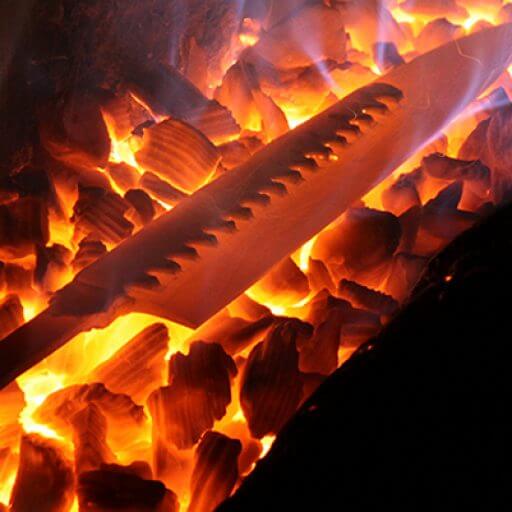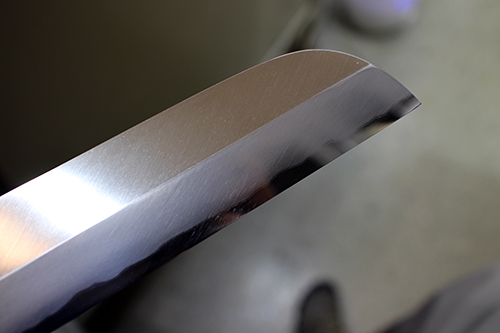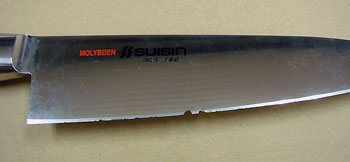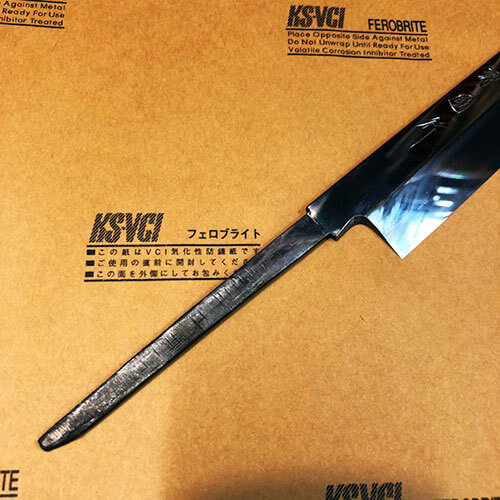Blade Dilemmas: A Chef Student’s Quest for the Perfect Edge

This afternoon, a foreign student from a culinary school visited the shop.
He asked, “Can I see some Usuba knives?” so I started explaining various aspects of them.
Then, he suddenly said, “Actually, I brought my own knife. Would you mind taking a look?”
He pulled out his KamaUsuba, and I gave it a careful inspection.
It turned out to be quite a tricky blade to sharpen… but—wow! He had done an incredible job.
Without thinking, I blurted out, “This is amazing! It’s already perfect as it is!” (Lol)
As a knife shop, I suppose I should’ve said, “I have something even better for you!” and tried to sell him a new knife. (Lol)
But he still seemed unsatisfied, so we took the time to go over everything—
Why does he find this knife difficult to use?
Which whetstones does he use?
What’s his sharpening routine?
What exactly is bothering him about it?
As we talked, I realized that he had come to the conclusion that his own sharpening might have made the knife harder to use.
First, his KamaUsuba was a V-Gold 10 Kasumi knife.
The whetstones he used were:
1000 (unknown brand)
2000 (unknown brand)
5000 Arashiyama
8000 Kitayama
Natural stones (Utigumori & Nakayama)
It seems he was chasing an even sharper edge, so he went as far as purchasing natural whetstones.
He meticulously flattened all his stones,
adjusted his sharpening to match the subtle twists in his blade— (this part is seriously impressive!!)
and even invested in the legendary Nakayama Awasedo, known as the ultimate finishing stone.
Yet, despite all this effort, he still couldn’t achieve the cutting performance he was looking for.
That’s why he finally decided to come all the way to SUISIN—to get a new knife.
With all the information gathered, I started explaining the unique characteristics of his KamaUsuba.
‘V-Gold 10 has these specific properties as a steel…’ I began, discussing its traits.
As we talked, I pointed out the issues he had experienced while using his knife,
suggested solutions, and helped him balance his ideal sharpness with practicality.
In the end, given the way he used his knife, natural stones weren’t necessary.
Even his #5000 Arashiyama wasn’t the best match,
and Kitayama was actually too fine for what he wanted!
When I told him this, he looked completely shocked—
‘Wait… what?!’ He was clearly confused and a bit frustrated…
but knowing that his profession requires him to cut quickly, cleanly, and reliably,
I was upfront about everything.
After we wrapped up that conversation, he asked,
‘Is there a good whetstone you’d recommend?’
So, I suggested the SUISIN #3000 finishing stone,
which I was pretty confident would give him the precise edge he was after—
and he ended up purchasing it!
Then he asked, ‘So, after this #3000, I use Arashiyama, then Kitayama, right?’ (smiles wryly)
I told him, ‘Just once—try stopping at #3000 and use the knife as is!’
We ended up chatting about Honyaki and other topics before he finally headed out.
I wonder if he’s trying the #3000 now…
I really hope he gets a sharp, clean edge and enjoys using his knife!
2025 Web Admin Note:
With this article, we’ve finally caught up with the original site’s ‘Daily Training’ updates.
My translations may have been a bit rough, but I hope you enjoyed them!
Up until now, we’ve been updating three times a week,
but from here on, regular updates will end, and posts will be more occasional.
Thank you for your continued support!
2023-08-30





